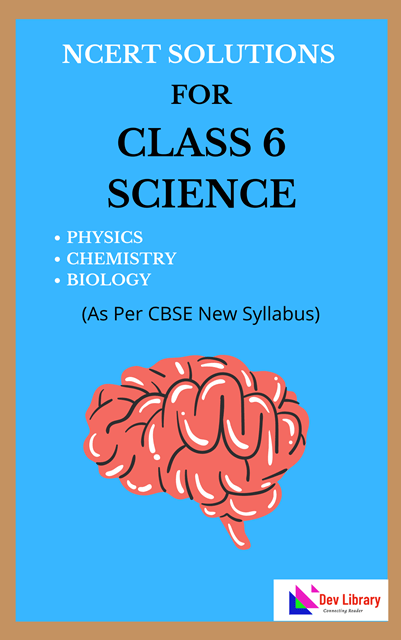NCERT Class 6 Science Chapter 12 Electricity and Circuits Solutions to each chapter is provided in the list so that you can easily browse through different chapters NCERT Class 6 Science Chapter 12 Electricity and Circuits and select need one. NCERT Class 6 Science Chapter 12 Electricity and Circuits Question Answers Download PDF. NCERT Class 6 Science Solutions.
NCERT Class 6 Science Chapter 12 Electricity and Circuits
Also, you can read the NCERT book online in these sections Solutions by Expert Teachers as per Central Board of Secondary Education (CBSE) Book guidelines. CBSE Class 6 Science Solutions are part of All Subject Solutions. Here we have given NCERT Class 6 Science Chapter 12 Electricity and Circuits and Textbook for All Chapters, You can practice these here.
Electricity and Circuits
Chapter: 12
NCERT TEXT BOOK EXERCISES
Q. 1. Fill in the blanks:
(a) A device that is used to break an electric circuit is called _________.
Ans: Switch.
(b) An electric cell has _________ terminals.
Ans: Two.
Q. 2. Make ‘true’ or ‘false’ for following sentences:
(a) Electric current can flow through metals.
Ans: True.
(b) Instead of metal wires, a jute string can be used to make a circuit.
Ans: False.
(c) Electric current can pass through thermocol.
Ans: False.
Q. 3. Explain why the bulb not glow in the arrangement shown in Fig. 12.12.

Ans: The bulb would not glow in the arrangement shown in figure because the one end of tester/screw driver is made up of plastic which does not allow the electric current of flow through it.
Q. 4. Complete the following drawing shown in Fig. 12.13 to indicate where t free ends of the two wires should be joined to make the bulb glow.
Ans:
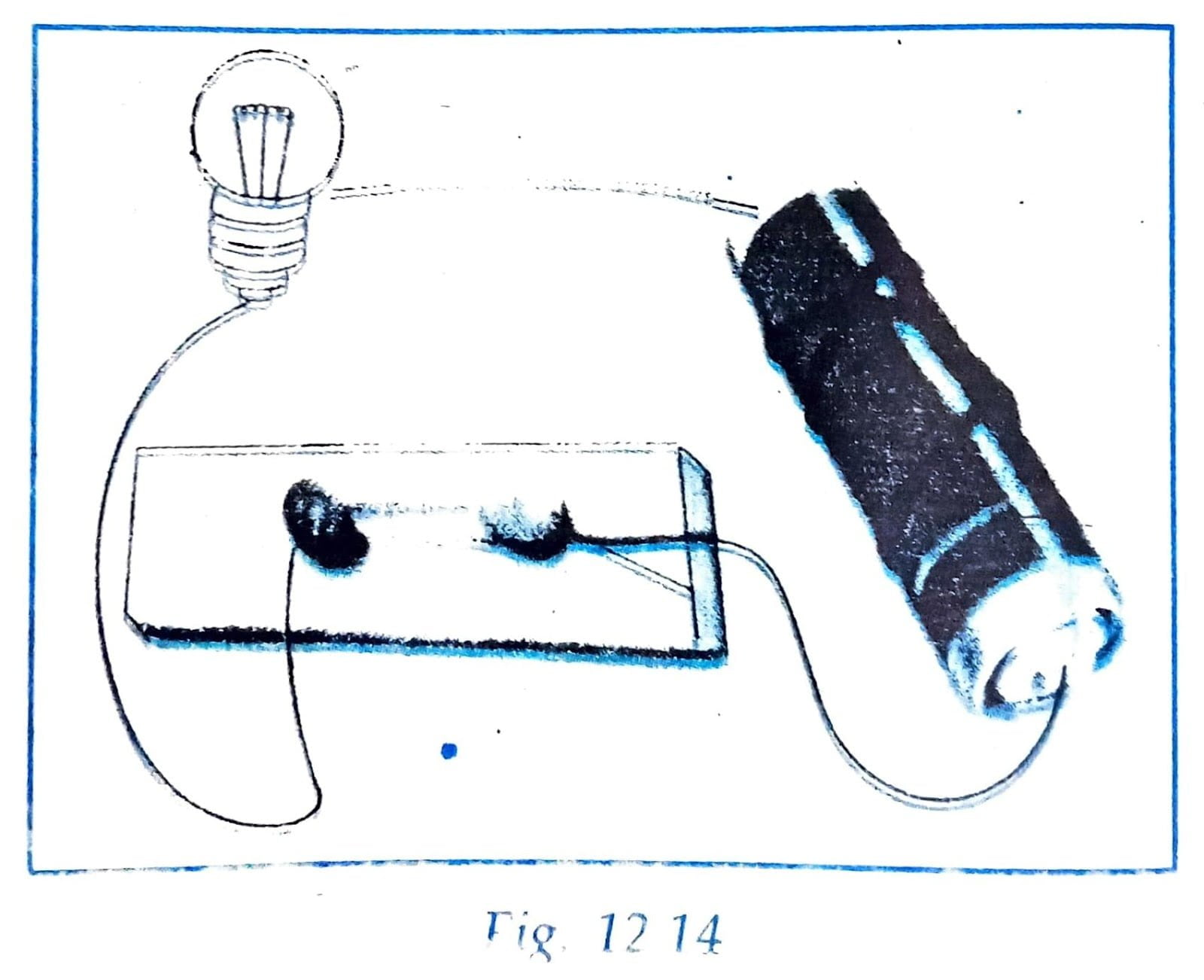
Q. 5. What is the purpose of using an electric switch? Name some electrical gadgets that have switches built into them.
Ans: An electrical switch is used to open the circuit or to close the circuit due to which electrical gadgets start or stop. Electrical switch is used in many electrical gadgets such as: Television, Washing machine, Electrical mixy, Toaster, Heaters, Press, Tube light, Electrical bulb, Torch, etc.
Q. 6. Would the bulb glow after completing the circuit shown in Fig. 12.15 if instead of safety pin we use an eraser?
Ans: No, since eraser is an insulator so it does not allow the current to pass. Hence, the bulb will not glow.
Q. 7. Would the bulb glow in the circuit shown in Fig. 12.15.
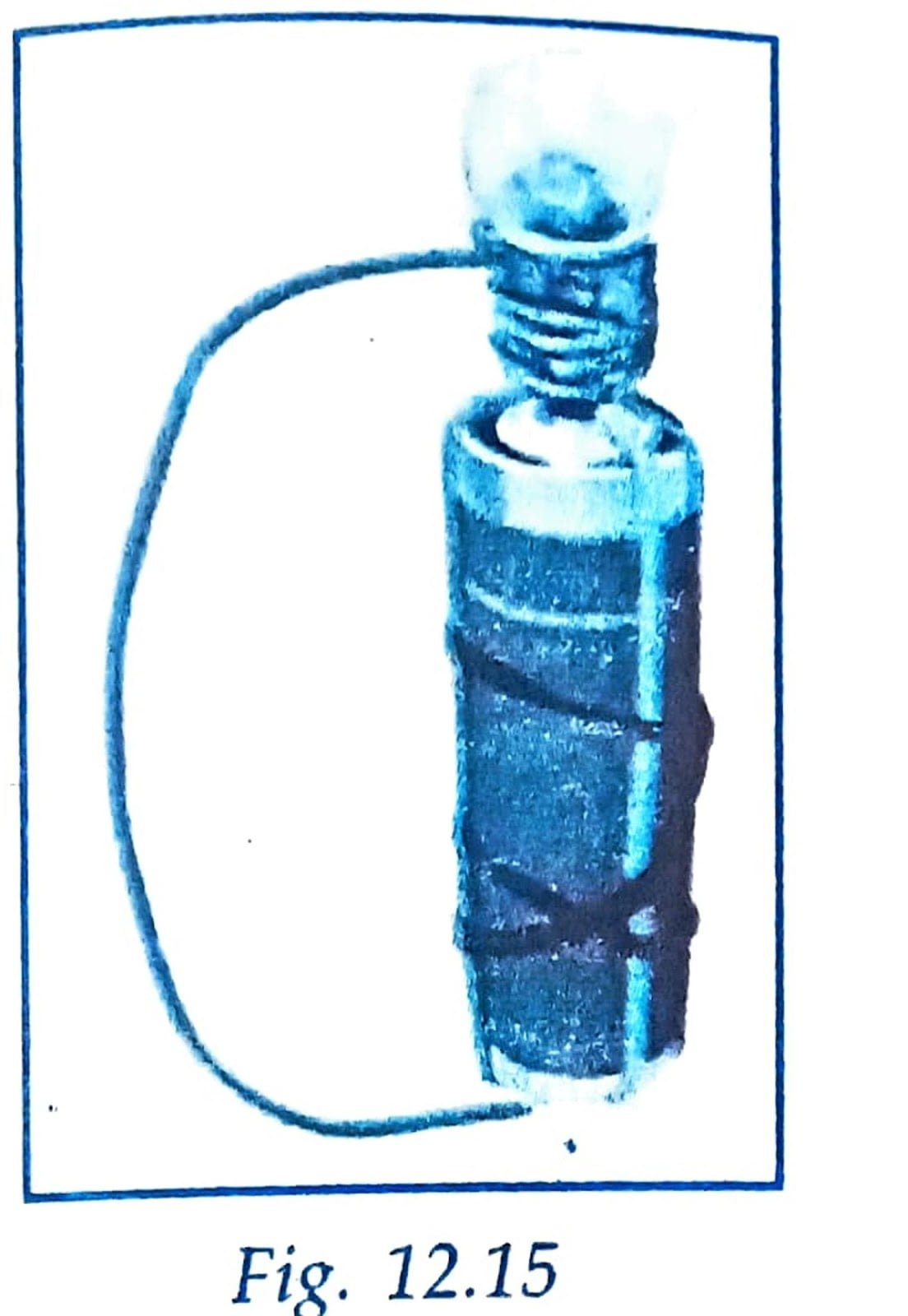
Ans: Yes, the electric circuit is closed so the bulb will glow.
Q. 8. Using the “conduction tester”on an object it was found that the bulb begins to glow. Is that object a conductor or an insulator? Explain.
Ans: Yes, if the object is good conductor of electricity then current will pass through conduction tester and the bulb will glow. Hence, the object will be a conductor of electricity.
Q. 9. Why should an electrician use rubber gloves while repairing an electric switch at your home? Explain.
Ans: Our body is good conductor of electricity and rubber is an insulator. During repairing work if the body comes in contact with current carrying wire then there will not be any accident as rubber does not allow the passage of current through it. Hence electrician uses rubber gloves while repairing an electric switch.
Q. 10. The handles of the tools like screw drivers and pliers used by electricians for the repair work usually have plastic or rubber covers on them. Can you explain why?
Ans: Plastic or rubber is an insulator which does not allow electric current to pass through it. The handles of the tools like screw drivers and pliers used by electricians have covering of plastic or rubber, so that electric current may not pass through these tools to the body of the electrician to harm him.
SOME OTHER IMPORTANT QUESTIONS FOR EXAMINATION
VERY SHORT ANSWER QUESTIONS
Q. 1. Name a common device which produces electricity from chemicals stored inside it.
Ans: Electric cell.
Q. 2. Which part of the torch bulb gives off light when it is connected to a cell by wires?
Ans: Filament.
Q. 3. A torch bulb has two terminals and a cell has also two terminals. In which case the two terminals are not marked + and –?
Ans: Torch bulb.
Q. 4. Name a device which is used to ‘open’ or ‘closed’ a circuit.
Ans: Switch.
Q. 5. Name the portable electric lamp which works with cells.
Ans: Torch.
Q. 6. In an appliance which type of material is used to make that part of the appliance:
(a) Which is to be handled by us?
Ans: Insulator.
(b) Through which electric current has to pass?
Ans: Conductor.
Q. 7. What is the direction of flow of current in a dry cell?
Ans: The current flows in closed circuit from +ve to -ve terminal of cell.
Q. 8. Name the + ve terminal of dry cell.
Ans: Carbon rod with a metal cap on it.
Q. 9. Name the -ve terminal of a dry cell.
Ans: Zinc metal plate.
Q. 10. What is open circuit?
Ans: The circuit in which electric contact at any point is broken is called an open circuit. No current flows in an open circuit.
Q. 11. What is closed circuit?
Ans: The circuit in which electric current flows from one terminal of a cell or battery to the other is called a closed circuit.
Q. 12. Name two materials which are conductors.
Ans: (i) Aluminium.
(ii) Copper.
Q. 13. Name two insulators.
Ans: (i) Rubber.
(ii) Plastics.
Q. 14. Can we use rubber/jute insta of metal wires to connect circuit?
Ans: No, we cannot use rubber/use connect circuit wires
Q. 15. What is a fused bulb?
Ans: When the filament is broken in bulb, it is called the fused bulb.
Q. 16. Define battery.
Ans: When two or more cells are ize together, we called it a battery.
Q. 17. What is an electrical cell?
Ans: Electrical cell is a source of electricity.
Q. 18. What is the function of key is switch) in an electric circuit?
Ans: Key (or switch) is used to put on or off the current in an electric circuit.
Q. 19. Write down the emf of dry cell
Ans: E.M.F. 1.50 volt.
Q. 20. If there is any gap in the path, will the bulb light up?
Ans: The bulb will not light up.
Q. 21. Name the part of a torch bulb which gives off light.
Ans: Filament.
Q. 22. What is solar cell?
Ans: It a device which converts solar energy into electrical energy.
Q. 23. Write one use of insulators.
Ans: Insulators are used in making switch board, handles of testers, screw drives.
Q. 24. In any electric circuit, when the switch is on and the current flows through it, why do the wire, switches, bulb or devices become hot?
Ans: This is because electric energy changes into heat energy.
Q. 25. What are the main constituents of an electric cell?
Ans: (i) Two electrodes. and
(ii) Electrolyte
SHORT ANSWER QUESTIONS
Q.1. Draw a diagram showing the two inals of a bulb.
Ans:
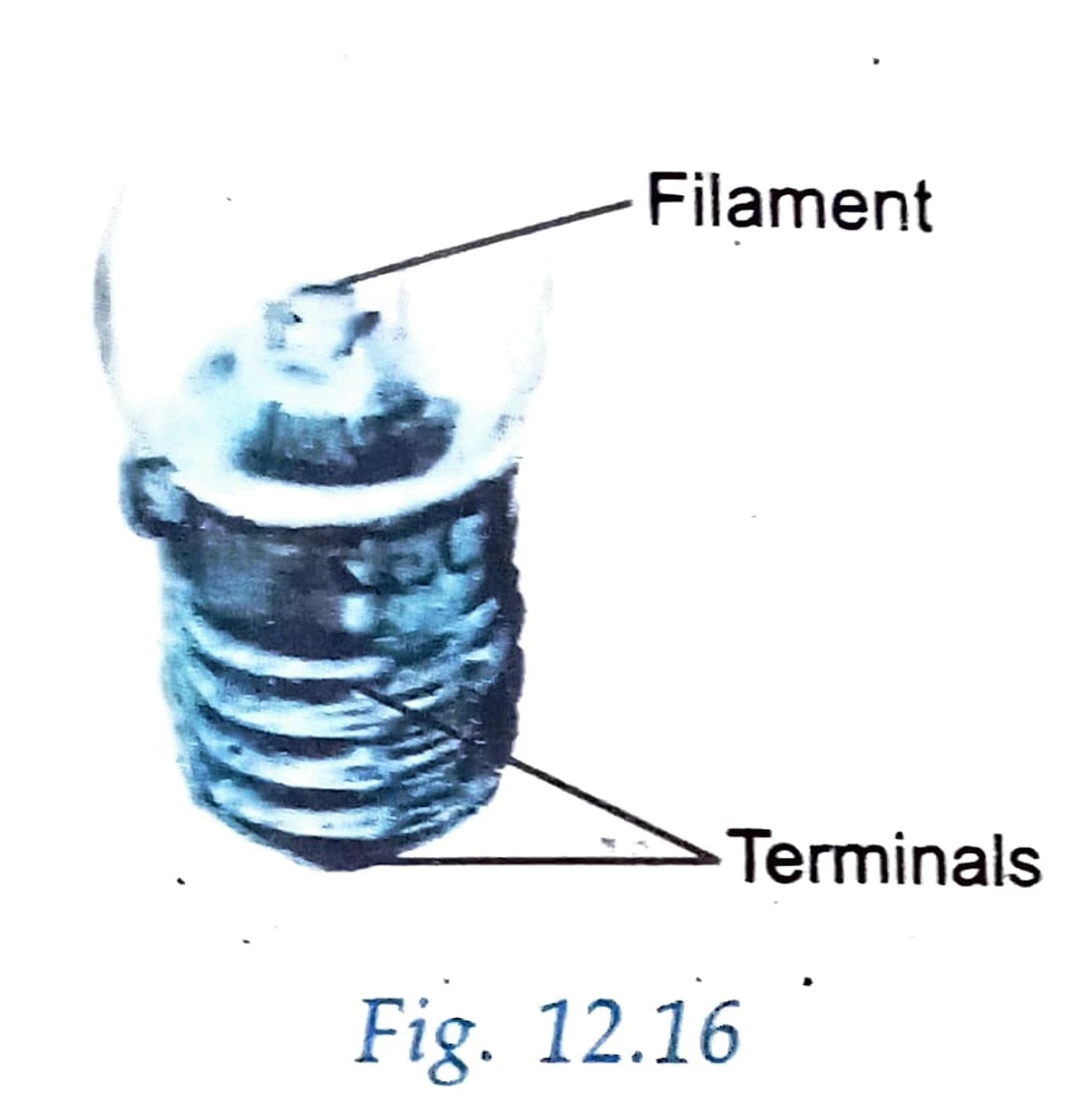
Q.2. Look carefully at circuit given below:
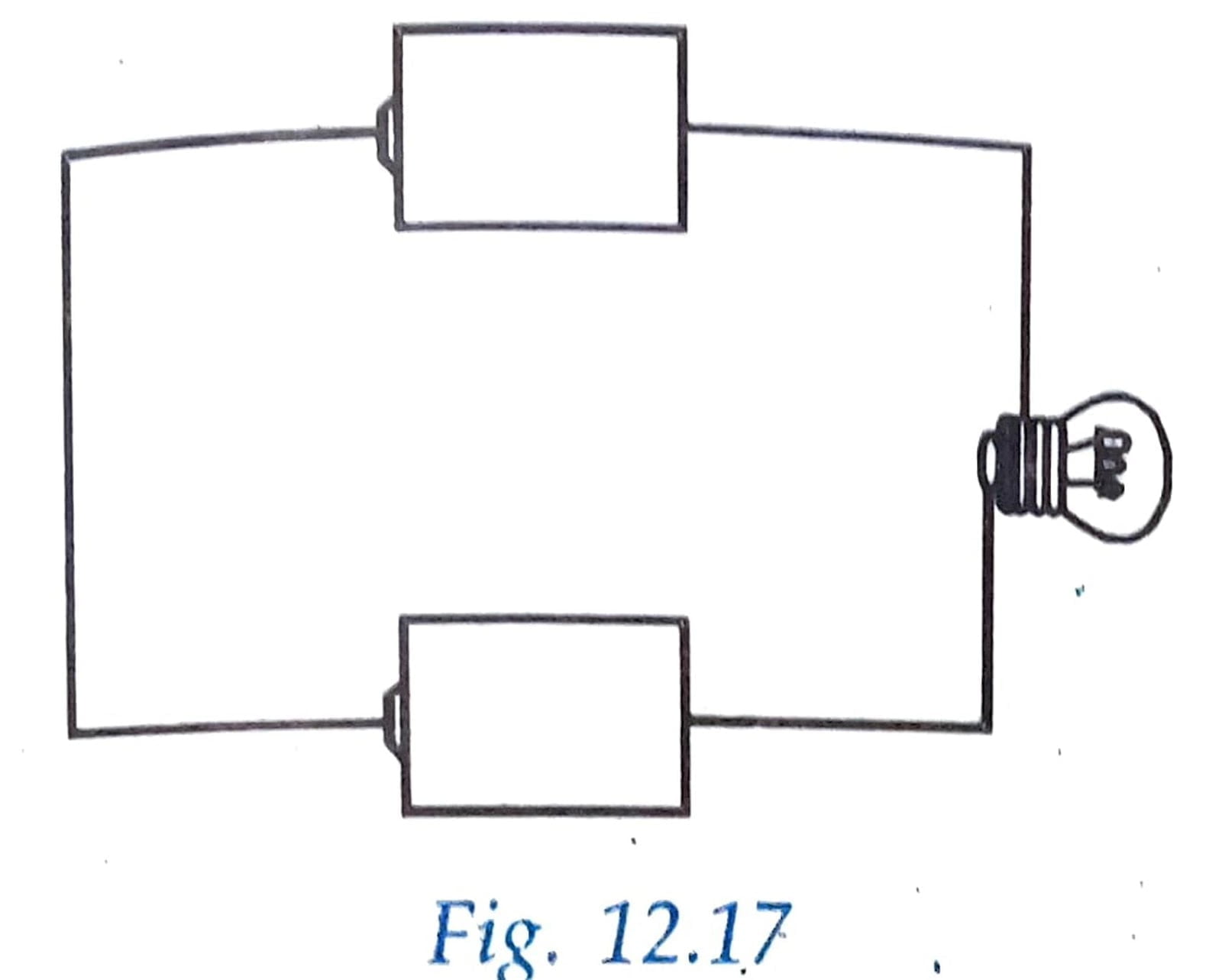
(a) In the above circuit, will the bulb light up?
Ans: No, the bulb will not light up.
(b) What is the reason for your answer?
Ans: The two cells are joined wrongly. The Positive terminal of one .cell is joined to the positive terminal of the second cell. Actually, the positive terminal of one cell should be joined the negative terminal of the second cell.
Q. 3. What are the two things that must be done to make the bulb light up in the following case?
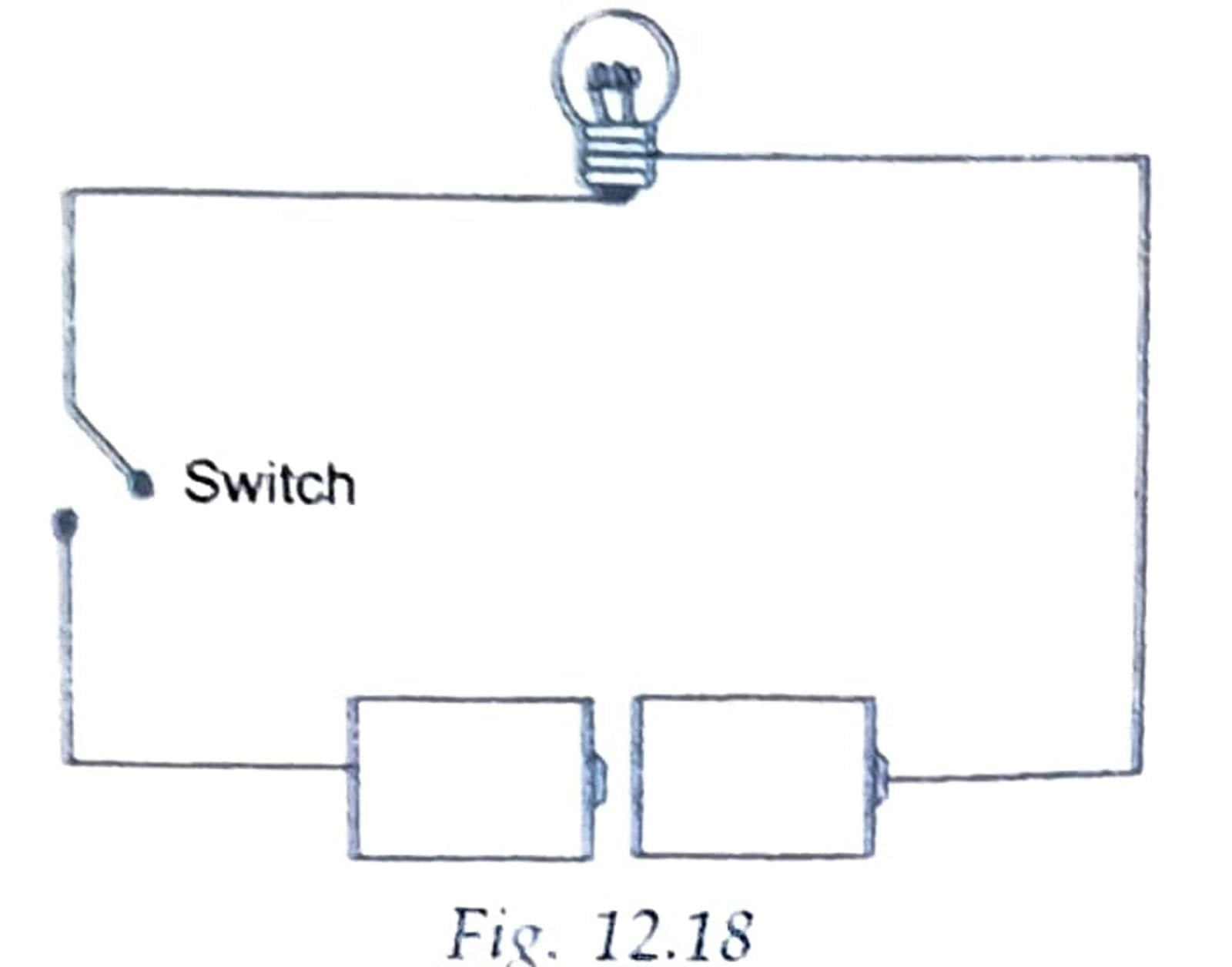
Ans: (i) Connect the positive terminal of left side cell with the negative terminal of the right side cell by using a wire.
(ii) Close the switch to complete the circuit.
Q. 4. What is the purpose of using an electric switch? Name four electrical appliances which have switches built in to them.
Ans: The purpose of using a switch is to ‘turn on’ or ‘turn off” an electrical appliance by closing the circuit or opening the circuit respectively.
Appliances which have inbuilt switches are table fan, room heater, washing machine, microwave oven, etc.
Q.5. Draw the inside of torch and label the following parts: Electric cell, slide switch, plastic casing, bulb, reflector.
Ans:

Q. 6. Why tungsten is used for making filaments of electric bulbs?
Ans: Tungsten metal is used for making the filaments of electric bulbs because it has a very high melting point (3380°C). Due to very high melting point, the tungsten filament can be kept white hot without melting away.
Q. 7. Draw a circuit containing one bulb and one cell.
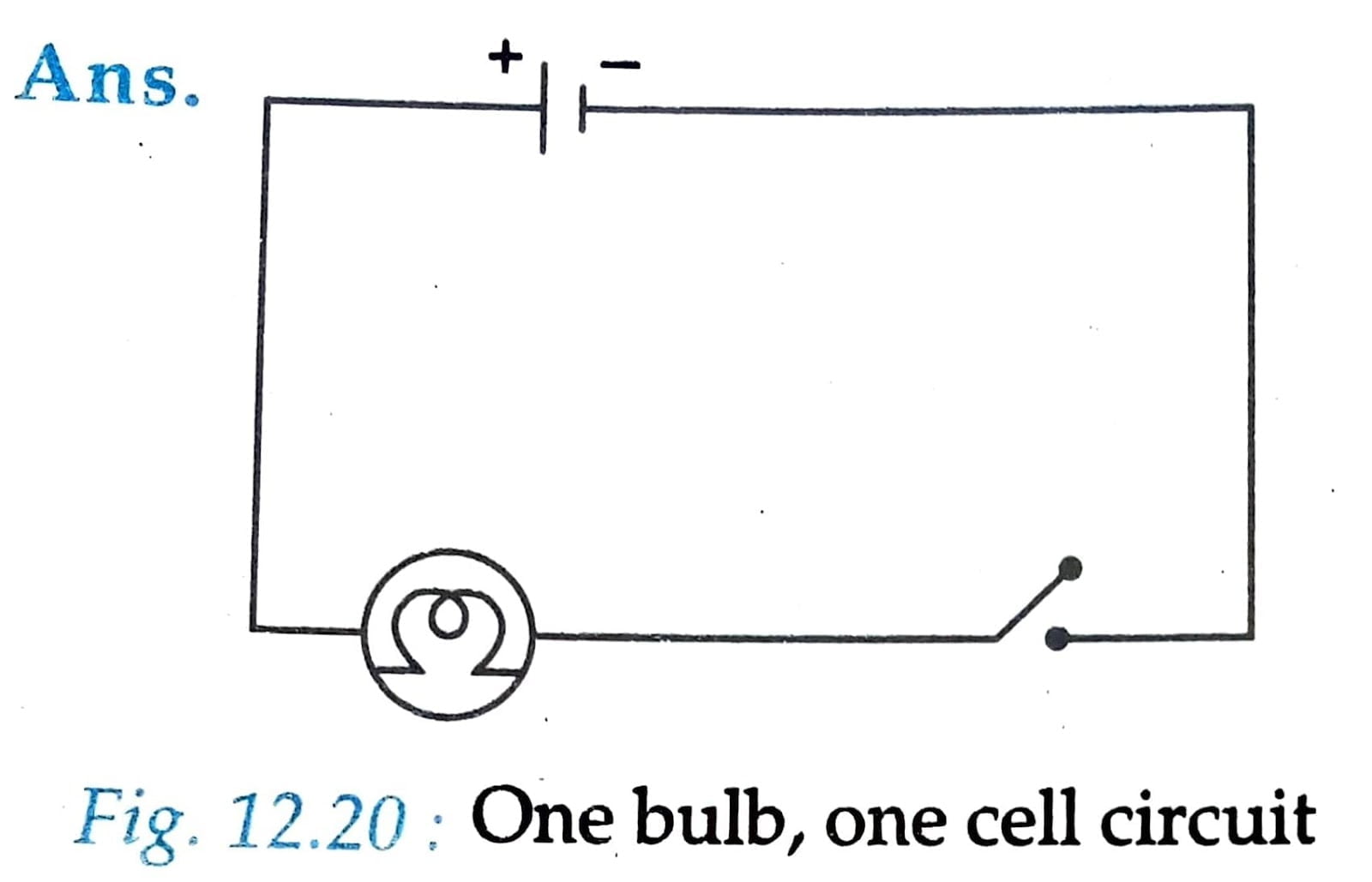
Q. 8. Draw a circuit containing two cells and one bulb..
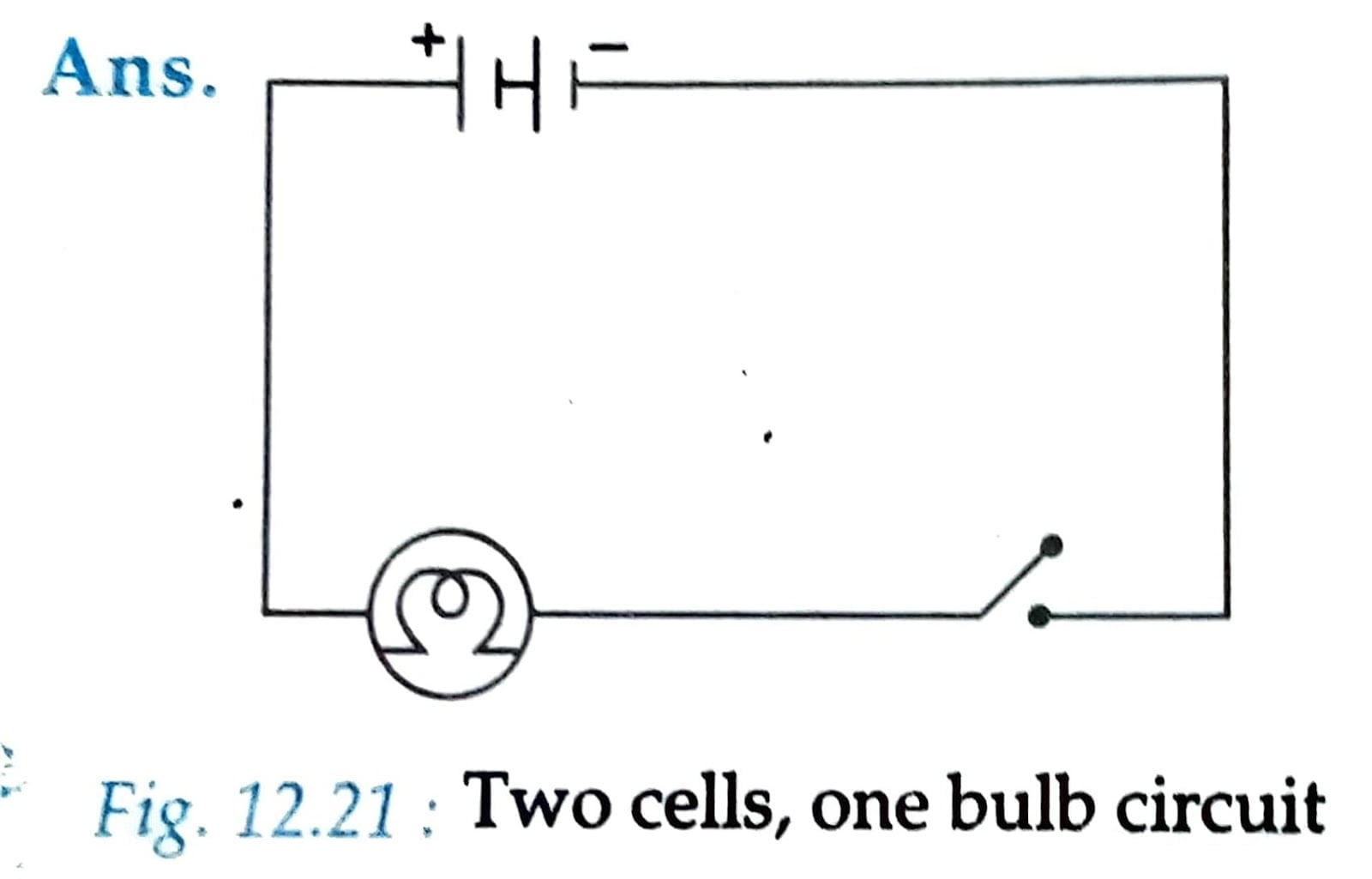
Q. 9. Draw a circuit containing three cells and one bulb.
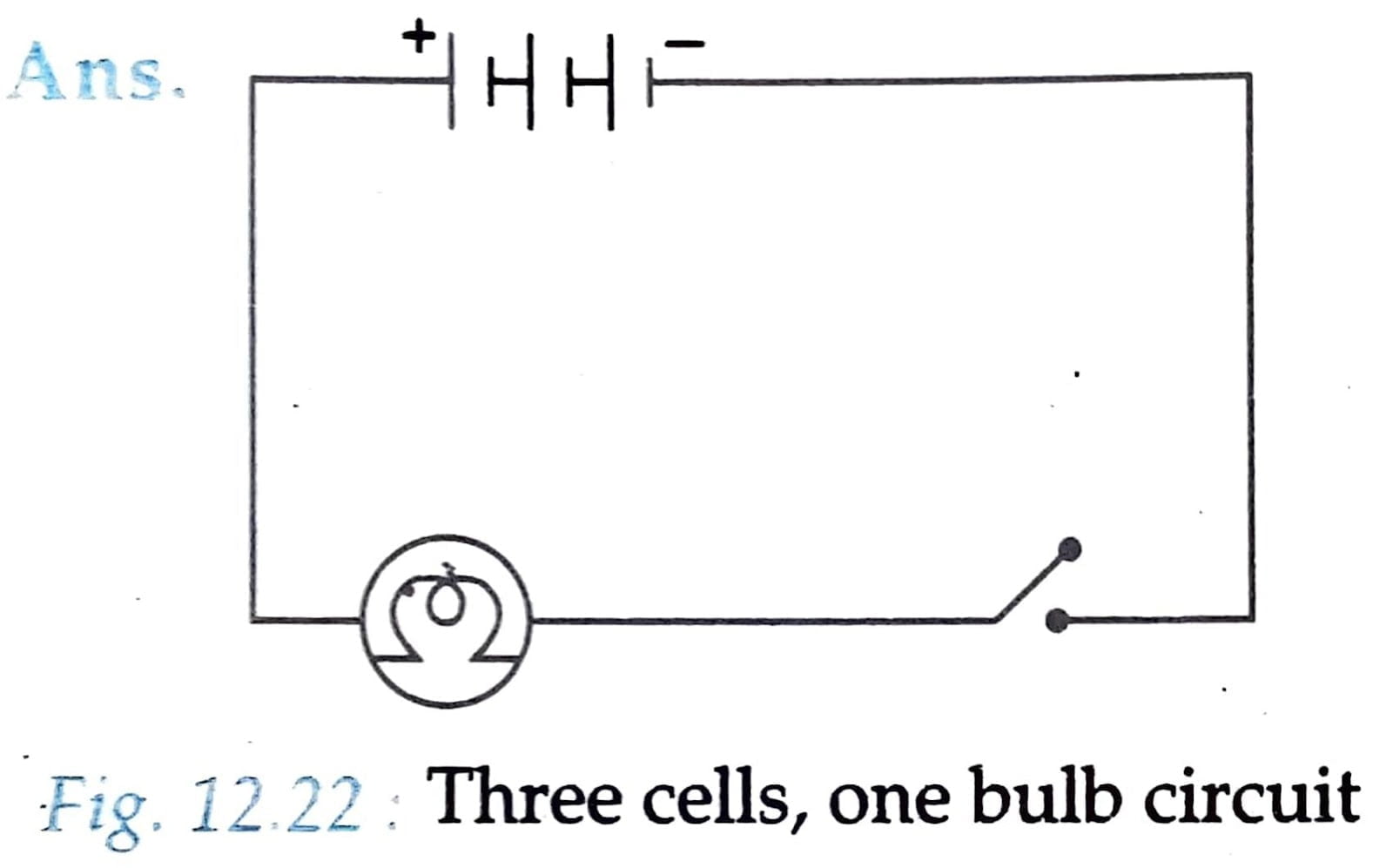
Q. 10. How does the bulb light up?
Ans: The bulb lights up only when the bulb and the wire complete the path which starts at one terminal of the electric cell and ends at the other terminal. If there is any gap in the path, the bulb does not light up. It also does not light up if the path starts and returns to the same terminal of the electric cell.
Q. 11. Why are copper wires usually covered with rubber/plastic?
Ans: A bare copper wire carrying current, if touched, gives an electric shock Such wires may also cause fire due to short-circuiting. To prevent short-circuiting and electric shocks, copper wires are covered with rubber/plastic covering.
Q. 12. Define conductors an insulators. Give two examples of each.
Ans: Conductors: Those materials which allow electric current to pass through them are called conductors. Examples: Silver, Graphite, etc.
Insulators: Those materials which do not allow electric current to pass through them are called insulators. Examples: Asbestos, Wood, etc.
Q. 13. What does each of the following in an electric circuit?
(a) Cell.
Ans: Cell: The electric cell produces a small amount of electricity.
(b) Bulb.
Ans: Bulb: It produces light when electric current passes through its filament.
(c) Wires.
Ans: Wire: Electricity is carried by copper wires.
(d) Switch.
Ans: Switch: Switch is used to open or close an electric circuit.
Q. 14. What is a switch? When we switch on an electrical appliance what changes are we making to the circuit?
Ans: The switch is a simple device which is used to open or close a circuit.
When the switch is turned on, the gap in the circuit is closed and a complete circuit is made. Due to complete circuit.
electricity starts flowing in the circuit and electrical appliance will now start working.
15. Why is it advised to clean the ends of connecting wires before connecting time?
Ans: Fresh connecting wires have an insulating layer on it. Similarly the connecting wires lying unused for some time may also develop an insulating layer. It is therefore important to clean the ends of connecting wires using a sand paper.
SHORT ANSWER QUESTIONS
Q. 1. Write three advantages of dry cells.
Ans: Advantages of dry cells:
(i) Dry cells are light in weight and small in size.
(ii) Dry cells can be transported from one place to another easily.
(iii) There is no fear of leakage/spillage in dry cells.
Q. 2. Why does a fused bulb not glow?
Ans: Bulb has a small filament inside it. As long as this filament is intact, it glows when connected to a cell. A bulb is said to be fused, when its filament is broken. The broken filament cannot complete the circuit. As a result, current cannot flow through the filament and the fused bulb does not glow.
Q. 3. The positive terminal of an electric cell was connected to a torch bulb fitted in a bulb holder. The other end of the bulb holder was connected to a crocodile clip. The negative terminal of cell was connected to another crocodile clip by a wire. When a material x was between the two free ends of the crocodile clips, the bulb did not glow but when another material y was held between the two free ends of the crocodile the bulb started glowing.
(a) What is the general name of the materials like (i) x and (ii) y?
Ans: (i) Insulator.
(ii) Conductor.
(b) Name one material each which could behave like (i) x and (ii) y.
Ans: (i) Rubber eraser.
(ii) Paper clip (of steel)
(c) Which part/parts of an electric plug is/are made of materials like (i) x and (ii) y?
Ans: (i) Plastic case.
(ii) Metal pins.
Q. 4. A and B are two devices. Both these devices have two terminals each. If the two terminals of device A are connected directly by a wire, nothing happens but when the two terminals of device B are connected by a wire directly, it gets damaged quickly. When the two terminals of device B are connected to the two terminals of device A, by copper wires, then part C of device A gets heated and glows to produce light.
(a) What could be: (i) device A, and (ii) device B?
Ans: (i) Bulb.
(ii) Cell.
(b) Name the part C of device A.
Ans: Filament.
(c) In which device, A or B, the two terminals are marked (+) and (-)?
Ans: B
Q. 5. How does electric current flow in electric cell?
Ans: The electric current flows from the positive terminal of the electrical cell to its negative terminal as shown in the Fig. 12.23.
In the bulb, the current enters through one of its terminals, flows through the filament inside the bulb and comes out through the other terminal of the bulb. The bulb lights up.
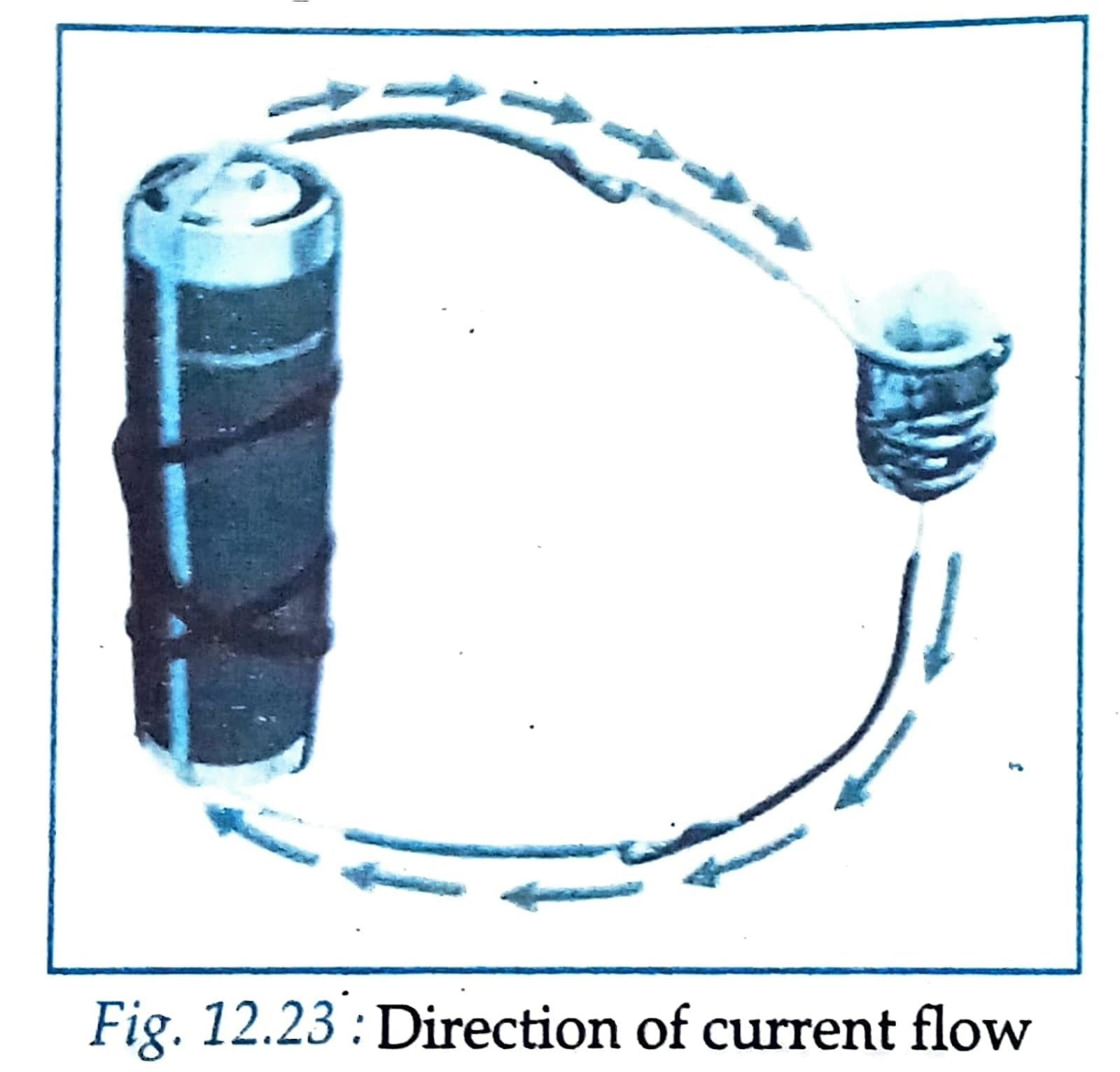
Q. 6. Give an activity to locate the two terminals of a call.
Ans: Take a dry cell and observe it carefully. We find the signs of positive (+) and negative (-) on it.
Observations: In a battery cell, there are two terminals labelled as + and -. The metallic cap at the top is the positive (+) terminal (marked as +ve) whereas the case of the cell is the negative terminal (marked as-ve).
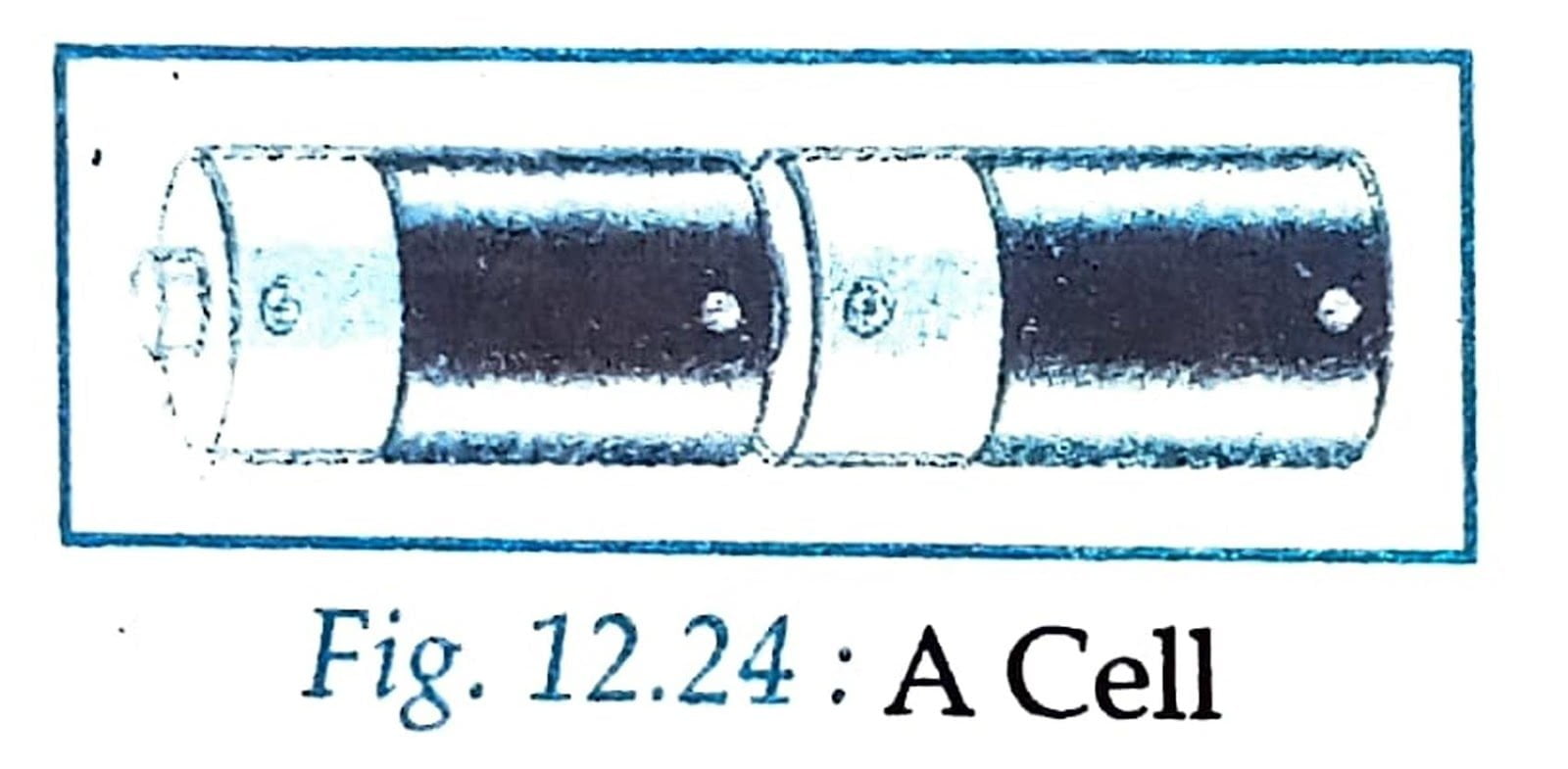
Q. 7. Conductors and insulators are equally important to us. Why?
Ans: We require things which allow electric current to pass through them as well as things which do not allow electric current to pass through them. Thus conductors and insulators are equally important for us. Switches, electrical plugs and sockets are made of conductors. On the other hand, rubber and plastics are used for covering electrical wires, plug tops, switches and other parts of electrical appliances, which people might touch.
Q. 8. Write three precautions a hazards of electric current.
Ans: Precautions:
(i) Wear rubber gloves or rubber chappals while handling electrical appliances.
(ii) Do not touch switches or electrical appliances with wet hands,
(iii) While repairing electrical appliances, check if it is not connected to the mains.
Q. 9. Write the components of an electric circuit.
Ans: In general, an electric circuit has the following components:
(i) A source of electric current such as one or more electric cells.
(ii) Covering wires which are normally insulated copper wires.
(iii) An appliance which uses the electric current, for example, a bulb or a electric iron.
(iv) A switch.
Q. 10. There is an impression among many people that a person touching a high power line gets struck with the line. Is this true? Explain.
Ans: This is wrong notation, because there is no attractive force that keeps a person stuck to the high power line. Actually, currents of the order of 0.5 A or even less are enough to bring disorder in our nervous system, which is electrical in nature. As a result, a person may temporarily lose his control over his nervous system, as a result, he is unable to pull himself away from the line.
Q. 11. What is short circuiting in an electric supply?
Ans: Short circuiting is the connection two points in a circuit across which the resistance is very low. As a result most of the current by passes part of the circuit and flows between these points.
Short circuiting occurs when the live wire comes in direct contact with the neutral wire such that a zero resistance path is provided to the current. The current then does not pass through the appliance, but a heavy current passes through the wires of the circuit.
LONG ANSWER QUESTIONS
Q. 1. Draw a labelled sketch of a torch. Give its various parts and working.
Ans: Parts of a torch: (a) A metallic or plastic casing,
(b) Torch bulb.
(c) Glass reflector.
(d) Metal switch contacts.
(e) Slide switch, (Two or three dry cells according to size of the cell.
(g) Metal spring attached to slide switch.
(h) Lamp contact.
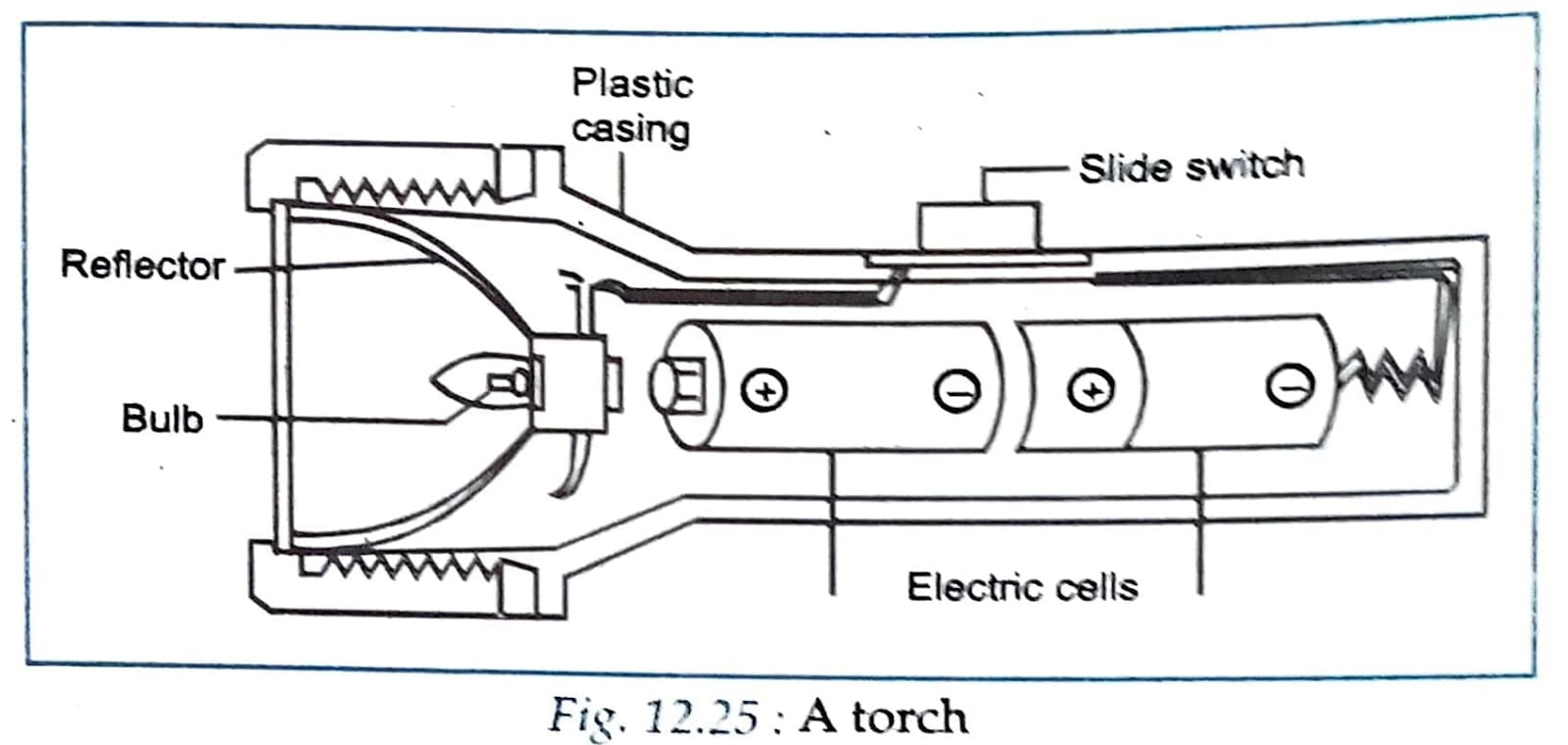
Working of torch: Electric current flows in the closed circuit. When slide switch is slided forward, cell contact is complete with the bulb, circuit is now closed. Electric current starts from one terminal of the electric cell and comes back to the other terminal of the electric cell. Bulb glows and starts emitting light.
Q. 2. Give an activity to find out the correct arrangement of cells in a torch.
Ans: 1. Take a torch containing 2 or 3 cells.
2. Open the screw cap of the torch, and take out the cells. Insert the cells in the following two ways one by one and press the switch.

3. Which of the two combination lights up the bulb? Only the arrangement: (i) lights up the bulb.
In a torch the cells are connected in such a way that negative end of one cell is in contact with the positive terminal of the other end and so on. In this way the positive terminal of the first cell and the negative terminal of the last cell are left free. The positive to negative combination of cells is called series combination of cells.
Q. 3. What is electric circuit? How many types of electric circuit are there? Define them. Draw a diagram to show the closed circuit for switch, bulb and dry cell.
Ans: Electric circuit: The complete path of flow of electricity from one terminal of the cell to its other terminal through various electrical components is called an electric circuit.
There are two types of electric circuit.
(a) Open electric circuit,
(b) Closed electric circuit.
(a) Open electric circuit: The circuit in which electrical contact at any point is!broken is called open electric circuit.
(b) Closed electric circuit: The circuit in which electric current flows from one terminal of a cell or battery to the other is called a closed circuit.
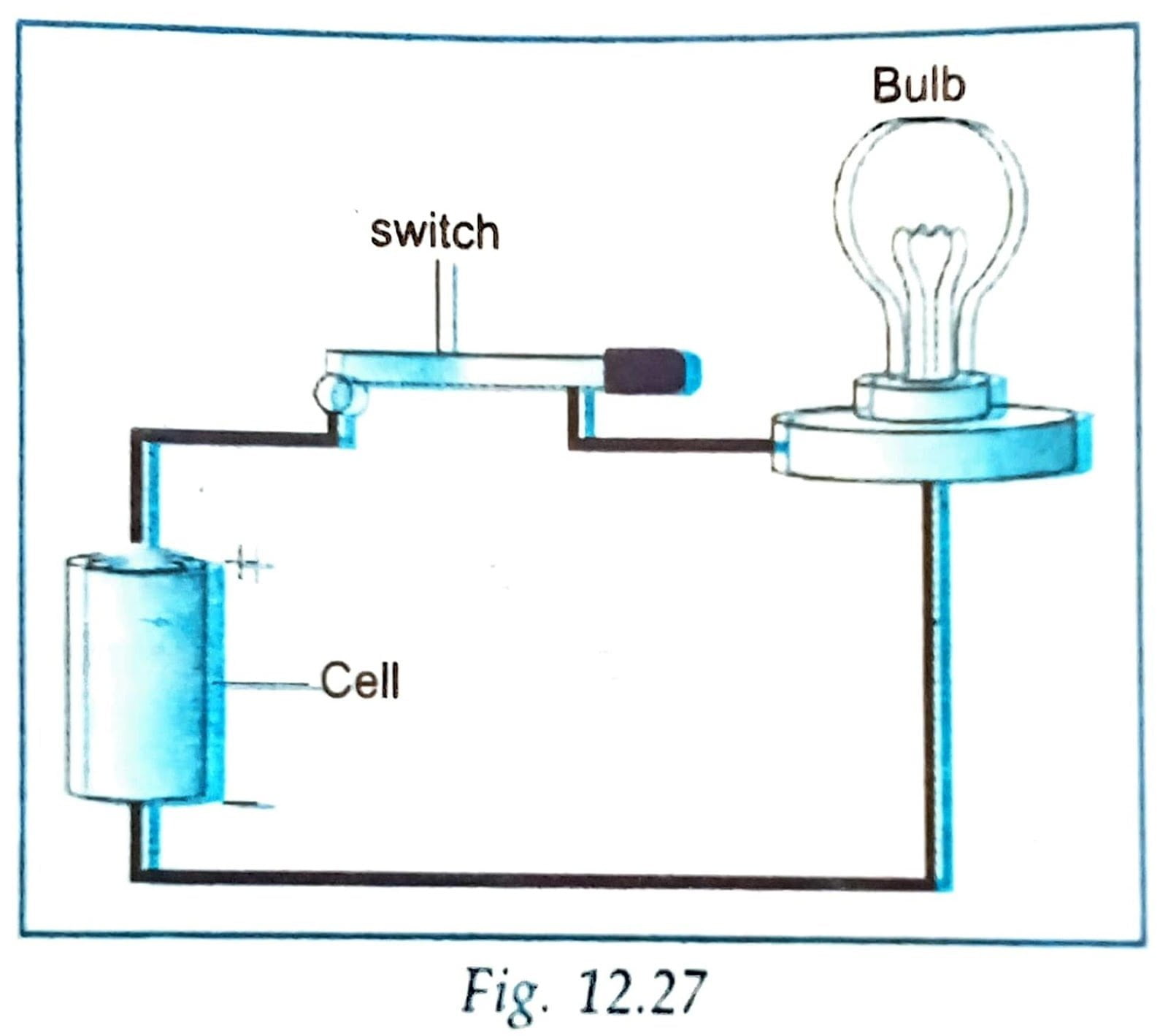
Q. 4. Does supply of electricity have two-way path?
Ans: Yes. There are always two wires coming from the electric power house. One of the wires brings the current and is called live wire The current coming through live wire passes through an electric appliance (such as a bulb, fan, etc.) and then flows out through another wire to power house. The wire which carries away the current to power house is called neutral wire.
These days there is a third wire, which is commonly called earth wire This wire is attached to the metallic bodies of the electric appliances. It is a kind of safety wire which protects us from electric shocks and electric fires.
Q. 5. Describe an electric bulb.
Ans: It consists of a tiny coiled wire,supported by two thick wires making a V- shape. This tiny coiled wire is called filament The two thick wires making this V-shape are called supporting wires. The lower end of one of these wires is connected to the metal casing at the side of the bulb. The lower end of the second wire is connected to the metal tip at the base of the bulb. The metal tip of the base and the metal casting at its lower end acts as terminals of the bulb. The space in between the terminals of the bulb is filled with sealing wax. This prevents the terminals from making contact with one another.
Where the electric current passes through the filament of the bulb through the terminals, it gets white hot and produce light.
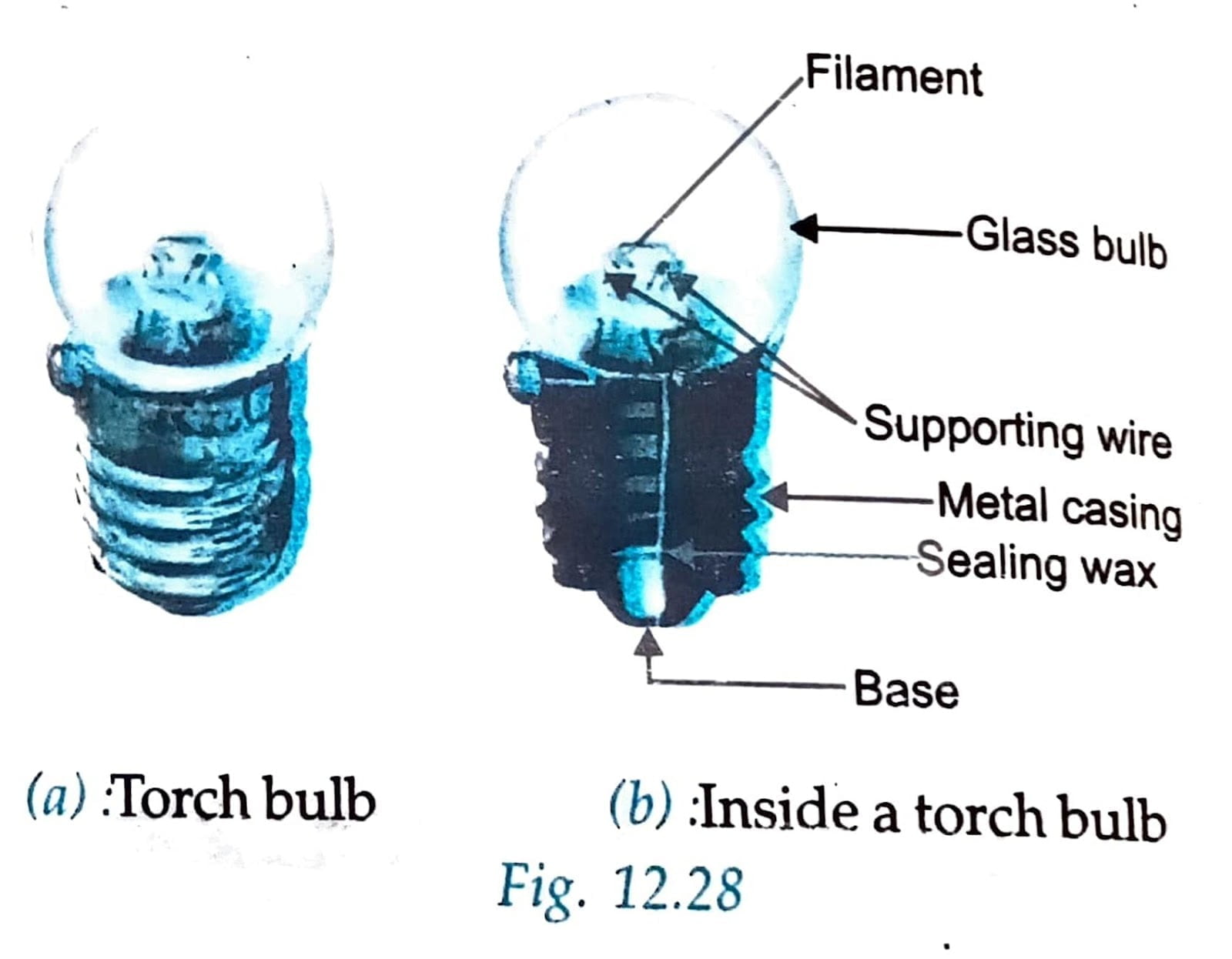
Higher Order Thinking Skill Questions
Q. 1. Will current flow more easily through a thick wire or a thin wire of the same material, when connected to the same source? Why?
Ans: The current will flow more easily through a thick wire as compared to the thin wire because the resistance of thick wire is less than that of thin wire.
Q. 2. Why are electric wires usually made of copper and aluminium?
Ans: Electric wires are usually made of copper and aluminium because they are very good conductors of electricity having very low electrical resistance.
Q. 3. What happens to the resistance as the conductor is made thinner?
Ans: As the conductor is made thinner, its resistance increases.
Q. 4. If you touch an electric wire carrying current you get a shock, but if on the same wire the birds sit they do not get any shock/current. Explain why?
Ans: When we hold the wire carrying current then the circuit is closed and the current flows from our body and enters earth but the birds sitting on the same wire do not get any current as the circuit is not complete. If the bird touches the earth wire, it will also die due to electric shock.
Q. 5. What do you understand by the terminal voltage of a cell? Why does the potential difference between the terminals of a cell fall when current is drawn from it?
Ans: In a closed circuit the potential difference between the electrodes of the cell is known as the terminal voltage.
When current is drawn from a cell, the potential difference between its terminals falls because the energy is spent in the flow of unit positive charge through the electrolyte.
Skill Based Questions
Q. 1. Label the parts marked I to V.
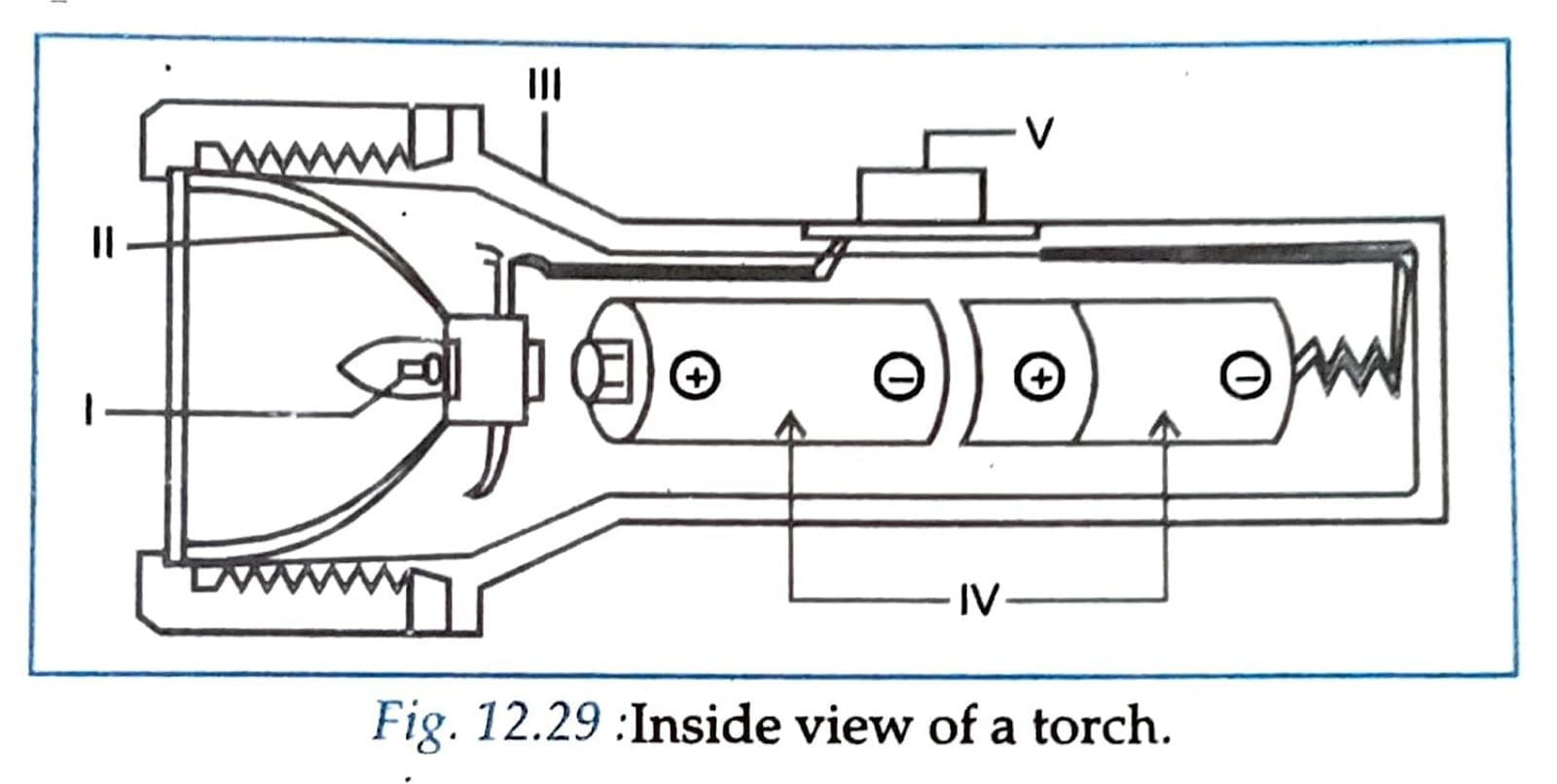
Ans: 1- Bulb filament, II – Reflector, III – Plastic or metallic casing, IV – Two cells connected in head to tail manner in series, V-Slide switch.
Q. 2.Identify the (+) positive and (-) negative terminal of a cell.
Ans: A is (+) positive and B is (-) negative.
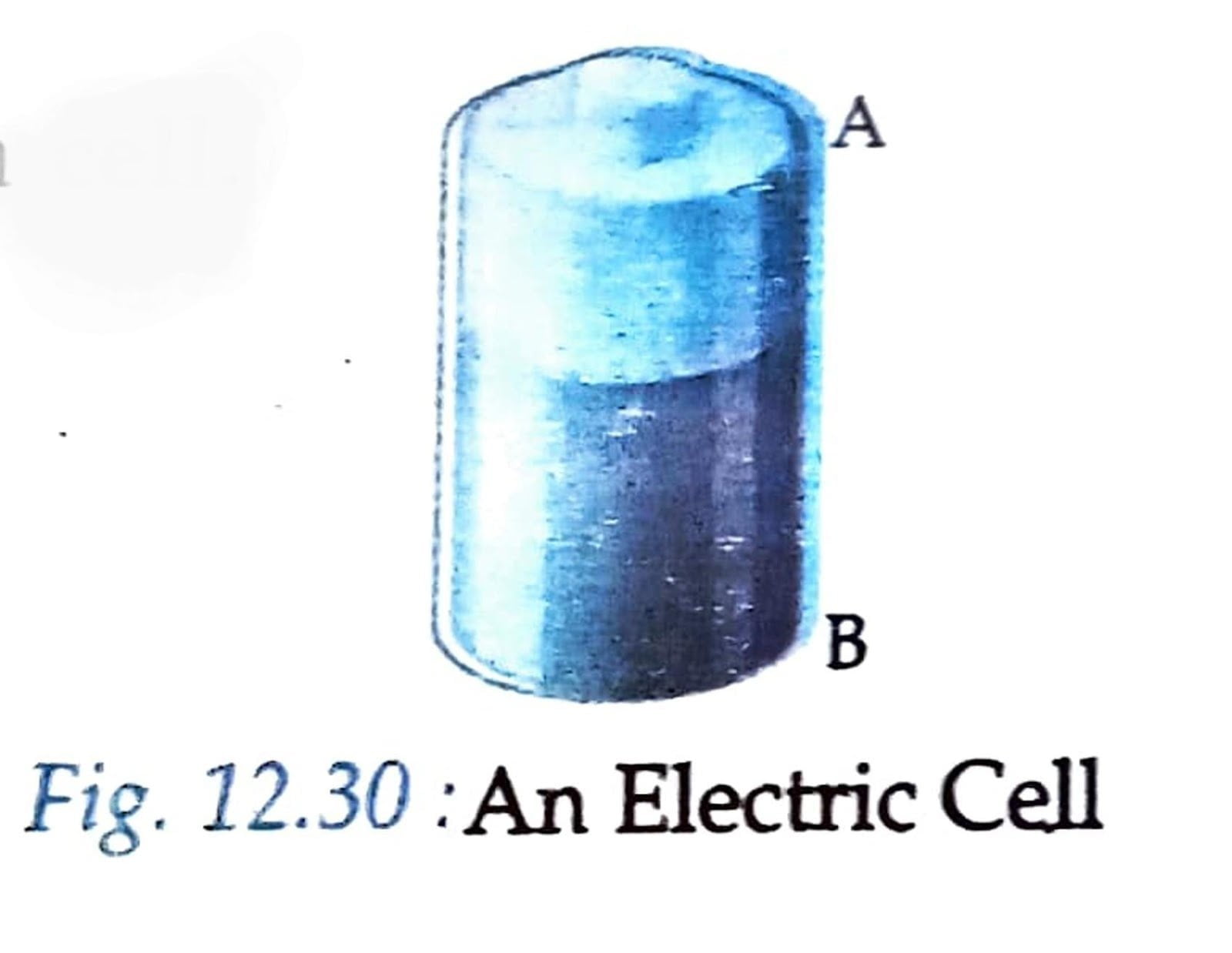
FORMATIVE ASSESSMENT
Q. 1. Fill in the following blanks with suitable words:
(i) Air is not a conductor of electricity, it is an ____________.
Ans: Insulator.
(ii) Electricity flows in ajan _____________circuit.
Ans: Closed.
(iii) The part of torch bulb that gives off light is the __________.
Ans: Filament.
(iv) An electric cell has _____________terminals.
Ans: Two.
(v) A device that makes or breaks a circuit is called ____________.
Ans: Switch.
(vi) An electric cell converts chemical energy to __________.
Ans: Electricity.
(vii) Materials that allow electric current to pass through them are called _____________.
Ans: Conductor.
(viii) Materials that do not allow electric current to pass through them are called _____________.
Ans: Insulators.
(ix) Two or more cells make ________when they are joined together.
Ans: Battery.
(x) ___________ and___________are examples of insulators.
Ans: Plastic, jute.
Q. 2. State whether the following statements are true or false:
(i) The electricity produced by portable generators is safe to use in science experiments in the school laboratory.
Ans: False.
(ii) The black rod in a dry cell is lead rod.
Ans: False.
(iii) Electricity can pass through thermocol.
Ans: False.
(iv) The electric cell produces DC.
Ans: True.
(v) Copper is a conductor.
Ans: True.
(vi) Rubber is an insulator.
Ans: True.
(vii) In a circuit using a cell, electric current flows from negative terminal to the positive terminal.
Ans: False.
(viii) The part of torch bulb which gives off light is the metal cover.
Ans: False.
(ix) The coloured plastic covering on an electric wire makes the electric wire resistance to corrosion.
Ans: False.
(x) A filament of an electric bulb is made of a thin wire of tungsten.
Ans: True.
Q. 3. Match the items given of Column A with those in Column B:
| Column A | Column B |
| 1. Thin wire in the bulb that gives off light. | (a) Conductors |
| 2. Provides a complete path for electricity to pass. | (b) Insulators |
| 3. Materials that allow electric current to pass. | (c) Metal disc |
| 4. Material which do not allow electric current to pass. | (d) Fused bulb |
| 5. Negative terminal of the electric cell. | (e) Filament |
| 6. A bulb that has broken filament. | (f) Electric current |
Ans:
| Column A | Column B |
| 1. Thin wire in the bulb that gives off light. | (e) Filament |
| 2. Provides a complete path for electricity to pass. | (f) Electric current |
| 3. Materials that allow electric current to pass. | (a) Conductors |
| 4. Material which do not allow electric current to pass. | (b) Insulators |
| 5. Negative terminal of the electric cell. | (c) Metal disc |
| 6. A bulb that has broken filament. | (d) Fused bulb |
Q. 4. Write one word for the following:
(i) A device that is used to put a circuit off and on.
Ans: Switch.
(ii) Combination of two or more cells in head-to-tail manner.
Ans: Battery.
(iii) A that produces electricity when sunlight is made to fall on it.
Ans: Solar cell.
(iv) The circuit in which current flows from one terminal of a cell to the other.
Ans: Closed circuit.
(v) A substance which does not allow electricity to flow through it.
Ans: Insulator.
(vi) An electric device which converts electric energy into light energy.
Ans: Bulb.
(vii) A material through which electric current passes easily.
Ans: Electric conductor.
(viii) A very thin coil of metal which glows brightly on passing electricity.
Ans: Filament.
(ix) A material which does not allow the electricity to pass through it.
Ans: Insulator.
(x) The ends of an electric cell or any other electric device.
Ans: Terminals.
MULTIPLE CHOICE QUESTIONS
(i) An example of non-conductor of electricity is a:
(a) Coin.
(b) Battery.
(c) Rubber gloves.
(d) Metal spoon.
Ans: (c) Rubber gloves.
(ii) Which one of the following is not an insulator?
(a) Bakelite.
(b) Brass.
(c) Porcelain.
(d) Mica.
Ans: (b) Brass.
(iii) Which one of the following is a conductor of electricity?
(a) Graphite.
(b) Granite.
(c) Ceramics.
(d) Thermocol.
Ans: (a) Graphite.
(iv) How many terminals are there in a dry cell?
(a) One.
(b) Two.
(c) Three.
(d) Four.
Ans: (b) Two.
(v) In an electric cell, the side with the metal cap is the:
(a) Positive terminal.
(b) Negative terminal.
(c) Filament.
(d) Bulb.
Ans: (a) Positive terminal.
(vi) A bulb whose filament is broken is called:
(a) Glowing.
(b) Conductor.
(c) Used.
(d) Fused.
Ans: (d) Fused.
(vii) The torch bulb does not glow in a close circuit in which one of the following is included. This one is:
(a) Paper clip.
(b) Aluminium foil.
(c) Mica sheet.
(d) Pencil lead.
Ans: (c) Mica sheet.
(viii) The coloured plastic covering on an electric wire makes the electric wire:
(a) Long lasting.
(b) More attractive.
(c) Resistant to corrosion.
(d) Safe to touch.
Ans: (d) Safe to touch.
(ix) A torch bulb which normally works on 4.5 volts electricity is connected to domestic electricity supply of 220 volts. Which of the following will happen to the torch bulb?
(a) It will glow very brightly.
(b) It will glow very dimly.
(c) It will not glow.
(d) It will get fused.
Ans: (d) It will get fused.
(x) The bulb lights up only when:
(a) The cell, bulb and the wires make a closed circuit.
(b) There is a gap in the electrical path.
(c) The path starts and ends up at the same terminal of the cell.
(d) The cell, bulb and wires make an open circuit.
Ans: (a) The cell, bulb and the wires make a closed circuit.
VALUE BASED QUESTIONS
Prabha’s mother was cooking in the kitchen for guest. Prabha saw her mother had plugged in microwave, hot plate and food processor on the same plug point. She immediately switched off the plug and removed all the plugs and re-plugged them in separate individual plugs.
(i) What happens when we use too many electrical devices plugged in one power point?
Ans: On plugging in too many devices at one power point causes overloading which can lead to electric fire.
(ii) What is power of a device?
Ans: Power of an electrical device is the amount of electric current used by it in a unit time.
(iii) What value of Prabha is seen in the above act?
Ans: Prabha showed the value of awareness and responsible behaviour.

Hi! my Name is Parimal Roy. I have completed my Bachelor’s degree in Philosophy (B.A.) from Silapathar General College. Currently, I am working as an HR Manager at Dev Library. It is a website that provides study materials for students from Class 3 to 12, including SCERT and NCERT notes. It also offers resources for BA, B.Com, B.Sc, and Computer Science, along with postgraduate notes. Besides study materials, the website has novels, eBooks, health and finance articles, biographies, quotes, and more.


